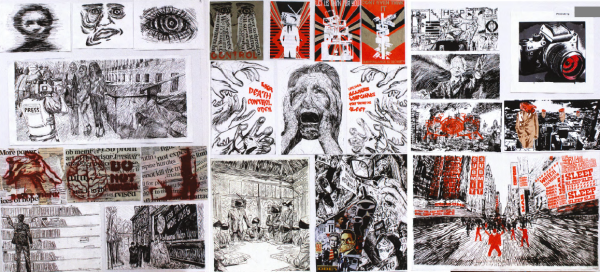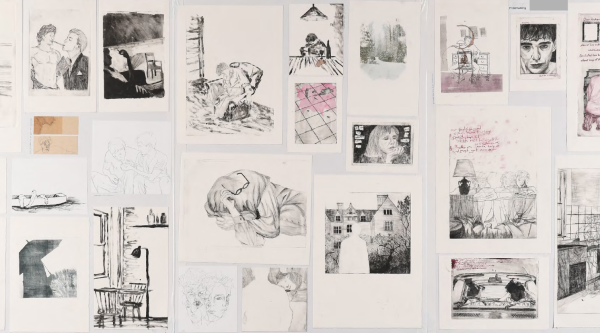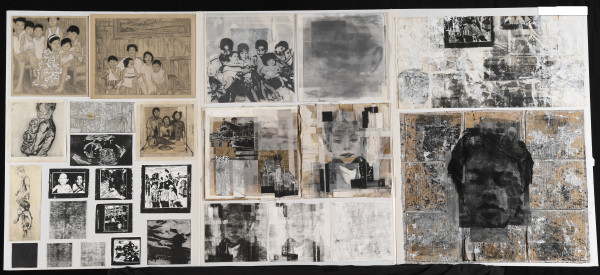2024 Scholarship
This Scholarship Printmaking submission establishes a proposition relating to media corruption and societal control. The enquiry inventively investigates in depth ideas and builds conceptually and pictorially through examining the idea that the media is manipulative and “shapes how we see the world, often distorting or controlling narratives.”
Ideas relating to isolation, grief, and desolation are informed by examining artists, including Käthe Kollwitz, Shepard Fairey, Banksy, and Edward Hopper to guide both pictorial and conceptual concerns. The workbook includes data and statistics and documents the thinking and the artistic exemplars behind each work.
At times there are also descriptions on how each work was made. Processes include collage, stencil, screenprint, drypoint, and woodcut. The final page of the workbook presents a three-dimensional assemblage offering possibilities for extension.
The workbook discusses ideas about fake news, misinformation, half-truths, propaganda, manipulation of the truth, brainwashing, selective storytelling, media saturation, the impact of social media and algorithms on young people, the blurry lines between facts and opinions, and biased reporting. There are references to the ideas of political theorist including Noam Chomsky and Edward Bernays. Soviet and Maoist propaganda posters and literature including George Orwell’s 1984 are also noted as inspiration.
The first panel sets up the idea of distortion and the media being drawn to sensation and glamour, rather than societal issues. The submission starts simply and builds momentum and complexity. In the smaller series, a hand symbolically controls puppet strings, and a figure is chained to a television. Collaged statements from newspapers help reinforce the proposition.
Panel 2 starts with works referencing political posters and goes on to present an image that clearly communicates the researched ideas by replacing faces with television screens or blindfolds. Text is used to build and extend ideas.
The focus on Panel 3 shifts to surveillance and the idea of ‘Big Brother’ watching over society. This final panel is provocative and creates a sense of being bombarded with billboard messages. Barbara Kruger’s work comes to mind with the messages to consume, work, buy, and obey.
This powerful and dynamic submission has clearly laid out workbook pages and a portfolio of successful compositions and works that confidently uses a limited palette of black, white, and red to define the subject matter through a combination of graphic and expressive media. The mix of screenprint and drypoint processes enable the candidate to create bold forms and shapes alongside detailed facial expressions.
To sit higher up the rank order in Scholarship Printmaking, the pages spent documenting and talking about works on each of the three panels would be better used investigating and testing further possibilities through artmaking. Space is valuable in the workbook so including photos of images seen on the portfolio is unnecessary.
The work successfully engages the viewer in reflecting on and questioning the nature of information we consume. We are reminded to be aware of the control media can hold over society, encouraging the viewer “to question the reliability of the information presented to them.”

On this page
2023 Scholarship
This Scholarship Printmaking submission is a personal project about Trans/Queer identity and the feelings and raw emotions that arise through repression of identity. The workbook is raw in its delivery of the thoughts and ideas that the candidate wrestles with daily, both in living life and when drawing and making prints. It is significant that they have chosen to bring the viewer into their world to both share and educate through their own lived experience of queer suppression.
Compositional spaces within the prints communicate the poignancy of the candidate’s experience and speak to loss, isolation, repression and intimacy. The candidate exercises an ethic of care in the way they make marks and compose each work on the folio. Evidence of the plate edge on prints is impactful and locates the image in space and the subject (themselves) in time within a scenario. The poses utilised throughout the work are authentically composed; looking at the work, we see into the figure’s world and understand and feel the nuance and tensions being communicated.
Visual devices are employed that conceptually nod towards the complexity of emotions and purposefully disguise their identity and presence through tactics like shielding and burying oneself. This ‘hiding in plain sight’ is established through figure poses and gestures, the absent figure and silhouette, subtle visual references to the ways they feel the pain of masking their identity through the imagery of everyday activities (e.g. drinking depicted through cans, bottles, a single glass and bottle, and red wine stain on the floor). There is a strong sensitivity to tone and form, light and contrast, including restrained use of colour, which is well-managed through printmaking conventions and technical care. Tonal shifts in ink and line equal a change in emotional state or mood. Likewise, when the image becomes jumbled with multiple line drawings layered onto one another, we visibly understand the tension and an audible shift of perception.
The workbook is predominantly notational, with many images of experiments and works in development and other exploratory processes/works that led to folio works (or were being made in parallel: painting and photography). Artist reference is relevant and provides ways for the candidate to think about mark-making in relation to emotion and how they can build a heightened sense of character, feeling and actions. The pace of the folio works beautifully, emphasising the tension of the felt emotions through its calm and spatially-considered format.

Download 2023's Scholarship Printmaking exemplar [PDF, 6 MB]
2022 Scholarship
This Scholarship submission delves into themes of personal identity, cultural collision, and the candidate's relationship to artmaking. Their perspective on identity is that it embodies the experiences and values accumulated throughout their life, with deep ties to their family and across generations.
Hailing from the Philippines, they explore their cultural background, living conditions, past life, early childhood, and traditions. The central subject matter revolves around memories and the contrasting differences between their life back in the Philippines and their current life in New Zealand, specifically addressing the dichotomy of poverty versus wealth.
The artworks involve a translation of photographs into prints through digital processes and various print techniques, such as drawing, mixed media, woodcuts, etching, pronto printing, screen printing, and cyanotype. These techniques serve to expand and extend the possibilities of mark-making. The individual layers in their works each correspond to specific moments in time or images, and these layers symbolise the layering of memories, both literally and metaphorically. This effect is achieved through the use of transparency, veiling, tracing paper, and a sensitive approach to mark-making, which includes the incorporation of mixed media like tape.
Different surfaces are utilised to communicate tone and meaning, including collagic application of the candidate's own ripped-up prints, reinforcing the idea that "memories are layered, non-linear, and sometimes misleading." Technical aspects like blurring, obscuring, wiping, fading, and torn edges are employed to convey a sense of time, effectively capturing the fragility of memories across and over time.
The exploration is deeply personal for the candidate, who considers it an insightful learning experience fostering personal growth. The workbook includes subheadings that outline the depth of their search and the lines of inquiry pursued: Personal Growth, Memories/Identity, Cultural Collison/Transition, Existentialism/Mortality, and Exploration of Space & Time/Abstract. These contexts not only support but also document the candidate's progression through their own process of self-reflection, discovery, and journey through life.
Artistic references play a crucial role, chosen for their techniques and conceptual underpinnings, which further enrich the proposition. In the workbook, the candidate engages in a highly reflective process of analysis, seamlessly shifting between questioning, describing thoughts, and exploring drawing and printmaking media/processes. Their interest lies in the potential of images, drawing, and printmaking to communicate the complexity of living and the "invisible aspects of emotion, the unconscious, and memory."
Each image in the portfolio captures a distinct moment, realisation, or episode from the candidate's life, collectively representing their unique story and journey of discovery and growth from their origins in the Philippines to their present life in Aotearoa New Zealand.

Download 2022 Scholarship Printmaking workbook pages [PDF, 33 MB]

